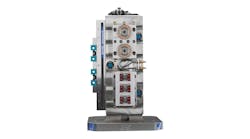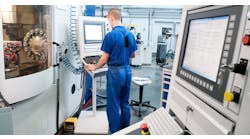It’s the early 1990s, and a group is forming near the center of a manufacturing shop floor. The ops manager reviews a spreadsheet on his clipboard and calls out “hot” projects, priorities, and line adjustments for the day. The team receives their assignments, returns to their lines or cells and begins work. Waterspiders (material handlers) begin moving tagged pallets from cell to cell, or to and from inspection. Production results are recorded on paper then entered into the ERP system by the production associate. There are only a handful of computer workstations on the floor, in the mainframe green screen format. Drawings are hand delivered and occasionally may only amount to “guidelines,” because through trial and error the machine operator has discovered some necessary adjustments…variances that only live in his head. There’s no documented training protocol for knowledge transfer, so when a new operator is trained, will those nuances be shared?
I started working in manufacturing in the 1990s at a plant that operated very much like this fictional one. My Dad had worked there for years, first as a technician, then as a supervisor, and eventually as an operations manager, and we talked extensively of the struggles to modernize the floor and the ways people worked.
Today, manufacturing is on an exciting path to modernization through advanced technologies. Automation allows for production schedule changes in real time, a daily and sometimes hourly exercise, which keeps the organization working to the plan. Updated and versioned drawings are sent directly to the floor, and modifications to CNC programs are communicated immediately to programmers. Connected equipment self-reports operational data, well beyond a piece count to tooling health, creating a predictive maintenance cadence that optimizes machine downtime. Through mixed-reality devices, remote guides and learning applications, what was once word-of-mouth knowledge transfer is now thoughtfully developed training, allowing new employees to work independently sooner and elevating output quality.
This is all good news for attracting talent into a sector that has not been on the top of career interest lists for some time. To launch, grow, or optimize these modern capabilities in manufacturing, here are four professional roles in which manufacturers should offer a compelling and growth-oriented technology career path:
1. Industrial engineer. A job previously in some decline, AI will bring it back to critical need. For example, rethinking shop floor layout, which previously required an extensive, time-consuming effort with the R&D team, can be rendered now through digital twins, which can serve as indistinguishable digital counterparts to the physical plant for simulation and testing. Also, as manufacturers look to optimize takt time through automated processes, industrial engineers will be crucial in programming and oversight.
2. Robotics engineer. There’s a reason 5S has adapted to 6S – the sixth S is “safety.” Anytime a human is near a machine, there’s a risk of injury, and regulations require impeccable maintenance of safety records. Robots can minimize human activity in unsafe conditions, and robotics engineers will be needed in warehousing and production areas to design, program, train, test, and maintain robotics, fueling this career need. Working alongside industrial engineers, robotics engineers will help optimize shop floor operations, OEE, and safety.
3. Production technician. No matter how many digital twins or robots manufacturers incorporate, the technology will never be a substitute for people having eyes and ears on the shop floor, as well as equipment and product. Today’s pace of new product introductions will necessitate technicians to report on production activities, analyze the metrics and make adjustments in real time in order to optimize output.
4. Programmer. If you’re machining a new part, someone has to tell the machine its dimensions and the placement of all its inserts and cuts. That person is the programmer, who will take the CAD drawings and either write new code or reconfigure already-existing code. So, what’s new? Well, we now have access to valuable data that supports determining optimal run speeds, tooling and cadences for the machining process. This data not only influences maintenance activities, but also helps in establishing the most efficient operating conditions for the equipment used in CNC machines.
To be clear, recruitment to manufacturing won’t be without its challenges. The pandemic unearthed flexible time and remote working opportunities in other sectors that are not realistic on the manufacturing floor. But I’m confident that manufacturers can overcome this potential drawback to recruitment by getting creative.
Promote the technology with which candidates will experiment and innovate, such as the gaming interfaces that so many enjoy in their personal life and will be instrumental in much of their work life. Emphasize role diversification, particularly effective for small-to-medium sized manufacturers competing for talent against large companies. Smaller manufacturers can highlight the opportunity to have many responsibilities – like working on robotics and digital twin and executing Gemba Walks – roles that should be very intriguing to recent grads as well as potential candidates who want to build their experience case. (At a larger company, there will be separate departments for all three areas, but employees will only work in one of them.)
And speaking of college graduates, for most universities, studies of manufacturing are on the decline, but manufacturers can entice early adopters from college into the sector. One of our manufacturing clients wanted to try digital twinning but was constrained by staffing capacity partnered with a local university that wanted to teach about digital twinning. They formed a partnership in which students gained real-world experience and the company grew its own knowledge – and saw the art of the possible at a reduced cost. Then, they brought on some of the university team to work as full-time employees.
Most important, don’t forget that manufacturing is a draw to many because the outcomes of efforts are tangible. In this age of digitization of nearly everything, there’s something highly satisfying about building things, and seeing the physical outcome of a day’s work.
And I’d be remiss in not stating that training and upskilling will play a critical role in preparing the existing manufacturing workforce, not just for the integration of technology, but for the integration of their new technology-focused colleagues. A change management lead should be appointed to structure and deliver a program that’s part of the continuous improvement of the workforce.
Education and enablement should be embedded into the culture of the organization—anchored by open communication and intentional engagement with the technology to understand why the company is integrating it. Define and help them understand their own leadership potential as the need for shop-floor subject matter experts arises, to drive adoption. Technology should be viewed as an opportunity, not a threat.
I’ve been in manufacturing and supply chain my entire career, and my family’s history in the sector goes back generations. Never has my enthusiasm been so high for sharing my passion about the fulfilling careers possible in this industry. Manufacturers across all product groups are embracing what it means to be a modern enterprise and making technology investments that demonstrate commitment. With that commitment to digitization, new skills will be needed to deliver on the promise of operational resilience and agility, and I believe the time is now to go after that talent. Tech stars – look here!
Jennifer Johnson is the Manufacturing & Life Sciences Applications Lead – North America with Avanade, an Accenture and Microsoft company that provides IT consulting and professional services.






